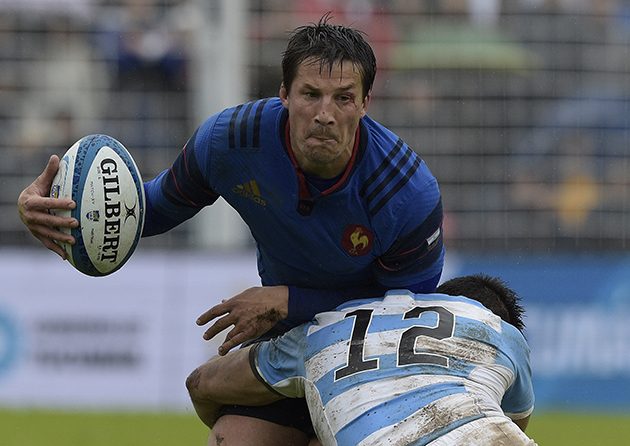Who will Guy Noves pick to wear the France No 10 shirt against New Zealand?
Spare a thought for Guy Noves. The France coach has to select a side to face the All Blacks in a month and one wonders where he’ll start when it comes to his back-line. On the credit side Wesley Fofana is on top of his game this season, and Morgan Parra and Maxime Machenaud are both looking good at scrum-half. They’ve options at full-back and on the wings but it’s France’s perennial problem position that must be giving Noves sleepless nights.
Which fly-half could possibly give France the direction and authority required to beat the All Blacks in Paris next month (not forgetting Samoa and Australia in the two preceding weeks)? The last man to give it a go was Francois Trinh-Duc, who wore the No 10 jersey in the 27-0 victory over the Pumas in Tucuman. He did okay in that game, managing the wet conditions better than his opposite number Nicolas Sanchez, but the Pumas that day were appalling, a shadow of the side that reached the World Cup semi-final nine months earlier.

Watching brief: Guy Noves oversees a France get-together last month. Photo: Getty Images
Trinh-Duc was in between clubs in the summer, having left Montpellier for Toulon at the end of last season, but his move up the Mediterranean coast isn’t going well. Not that he’s to blame. The conflict among the coaching staff – which appears to be over following the news of Monday that Diego Domiguez has been replaced by Mike Ford – has unsettled the club and Trinh-Duc, a confidence player who needs stability and support from his coaches, is suffering more than most.
However, the brutal truth is that the 29-year-old has never had it where it counts most – the top two inches – and in a career that’s now spanned nine seasons and 55 caps he’s never found the consistency to mark him out as a top-class fly-half.
That Trinh-Duc continues to be considered the solution by many in France to their fly-half problem is down to what this correspondent calls ‘Chabal Syndrome’ – turning an average player into a great one on the back of their media profile and not their on-field performance. If Sebastien Chabal achieved legendary status by growing a beard and growling, Trinh-Duc’s greatest gift is being a good bloke.

On the front foot: Camille Lopez has been in superb form for Clermont. Photo: Getty Images
So what are the alternatives? Noves must have despaired when he sat down to watch the weekend’s European competition. Of the 14 French clubs in action only five fielded a French fly-half: Toulon, Clermont (Camille Lopez), Bayonne (Lucas Meret), Brive (Thomas Laranjeira) and Grenoble (Gilles Bosch). Contrast that with the English clubs over the weekend, where seven of the 12 teams had home-grown fly-halves with an eighth, Leicester’s Freddie Burns, coming off the bench to steer his side to victory against Racing 92.
The form French fly-half this season is Camille Lopez. He’s shed a few pounds over the summer and looks sharper, quicker and more confident as a result. The fact he’s playing outside Morgan Parra and inside Fofana would therefore make him the logical choice for the autumn Tests, but bizarrely the 27-year-old wasn’t in the elite squad of 30 players that met at the end of September for a three-day training camp. That omission will surely be rectified in time for the three autumn Tests and also expect to see a return for Jean-Marcellin Buttin, the Bordeaux full-back playing the best rugby of his career four years after winning two caps as a precocious 20-year-old.

Central switch: Would Stade’s Jules Plisson be more effective at 12? Photo: Getty Images
The fly-halves Noves selected in September were Trinh-Duc and Jules Plisson, the Stade Francais star whose temperament and tactical kicking are as brittle as the Toulon No 10’s. Interestingly, Stade coach Gonzalo Quesada – who knows a thing or two about what’s required to be a top-class fly-half – selected Plisson at inside-centre for their Challenge Cup match against Timisoara Saracens last week with Morne Steyn at ten. Plisson played well, showing his pace to scoot through for an early try, and demonstrating that there are few French threequarters who can pass as crisply and accurately as he. Moving from 10 to 12 would relieve Plisson of the pressure of running the back-line while improving its creativity, particularly if Fofana – whose distribution can sometimes let him down – plays at 13.
But whoever Noves picks at fly-half, the responsibility will be enormous. The last time France beat the All Blacks was a 27-22 win in Dunedin in the summer of 2009 and since then there have been nine consecutive defeats, culminating in the 62-13 humiliation in last year’s World Cup quarter-final.
Playing at fly-half in that 2009 victory was a fresh-faced 22-year-old by the name of Trinh-Duc. He had the world at his feet that day but the Frenchman’s failure to kick-on lies in his head.
For the latest Rugby World subscription offers, click here.





